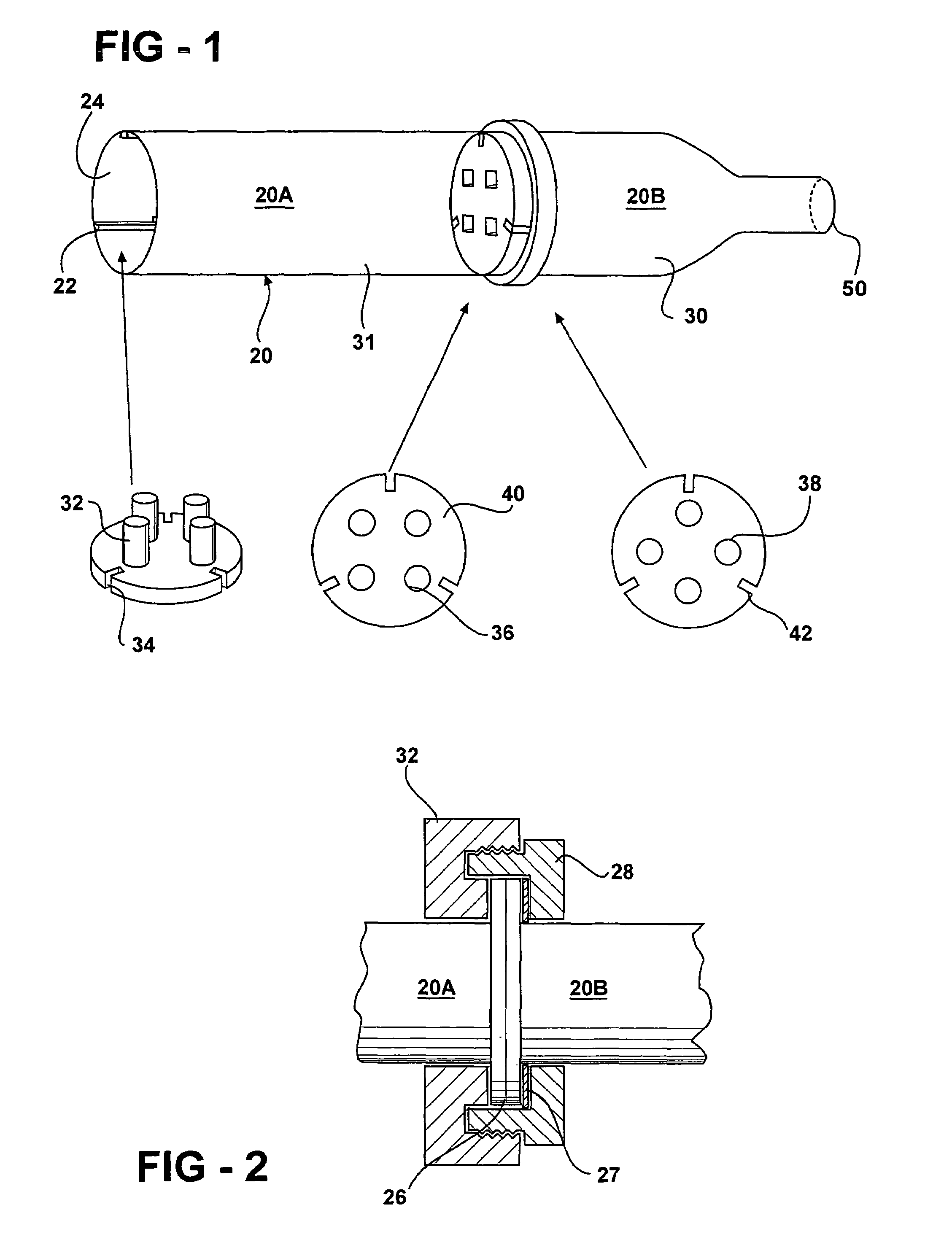Bone cement and a system for mixing and delivery thereof
a bone cement and mixing system technology, applied in the field of orthopedic adhesives, can solve the problems of affecting the performance of the device, mismatching of interface properties, and loosening of antibacterial properties
- Summary
- Abstract
- Description
- Claims
- Application Information
AI Technical Summary
Problems solved by technology
Method used
Image
Examples
example 1
nts
[0053]Simplex P bone cement was purchased from Howmedica International Inc. LUCITONE 199 was purchased from Caulk Dentistry (Milford, Del.). This particular impact modified acrylic powder is a copolymer of methyl methacrylate with butadiene and styrene, which is then coated with PMMA. F154 High Impact Polymer Clear (Esschem) was obtained from Esschem Inc. (Linwood, Pa.). This particular polymer is a rubber modified PMMA that is used as a denture base in the dental field. It contains 0.38% benzoyl peroxide (BPO). The particle size is 1% on 80 mesh, 1.5% on 100 mesh, 8.6 on 150 mesh, 36.4% on 250 mesh, and 52.4% on pan. Coe-Tray PMMA (assigned as PMMA) was purchased from GC America Inc. (Chicago, Ill.). In addition, Polybutene (PB) (Mw=9,000 g / mol from GPC measurements, Macomer, Revertex Ltd. Harlow UK), a copolymer of isobutylene-butene, which consists predominately of high molecular weight polyolefins with minor isoparaffin content, was also used in formulation. Barium sulfate (B...
example 2
[0054]A Perkin Elmer Sigma 3B GC with a Supelco 10% SP-2100 80 / 100 mesh column was employed to measure the residual monomer. A flame ionization detector was used to quantify the residual monomer amount. The injector, column and detector ports were set at 200, 185 and 190° C., respectively. The flow rates of helium, hydrogen and air were adjusted so both MMA and EMA gave narrowest peak widths and noticeably different elution times. The method employed a pentane or methylene chloride extraction of ground cement powder, since the residual monomer is soluble in pentane but PMMA is not soluble. Methylmethacrylate (MMA) and ethylmethacrylate (EMA) in pentane solutions were used to calibrate the instrument and EMA was used as an internal standard. A 1 μl sample was injected into the gas chromatograph. The ratio of the MMA to the EMA was determined by the height of the corresponding peaks from each of the chromatogram. The monomer content in the bone cement specimen was determined fr...
example 3
usion Chromatography (SEC)
[0055]The molecular weight and molecular weight distributions were determined in both the powder and the formulated cements using a customer made Waters size exclusion chromatography. A Waters HPLC pump (Waters, Model 590) was used for eluent delivery at 1.0 mL / min. A Waters 410 differential refractometer was used as a concentration detector. The instrument was running at 25° C. and equipped with three Waters Ultrastyragel HR3, HR4, and HR5 columns (Waters Corp. Milford, Mass.), measuring 30 cm in length and packed with 5 μm diameter PS Gel. The THF solvent was filtered and degassed before use. Samples were dissolved in THF at a concentration of 0.2˜0.4 mg / mL and preferably centrifuged before filtered with 0.2 μm pore size poly(tetrafluoroethylene) membrane filters (some rubber and radiopaque components could not be dissolved in THF). Injection volumes of 100 μL were used. TriSEC software (Viscotek Co.) was used for data treatment. A series of eleven PMMA s...
PUM
| Property | Measurement | Unit |
|---|---|---|
| Temperature | aaaaa | aaaaa |
| Temperature | aaaaa | aaaaa |
| Temperature | aaaaa | aaaaa |
Abstract
Description
Claims
Application Information
 Login to View More
Login to View More - R&D
- Intellectual Property
- Life Sciences
- Materials
- Tech Scout
- Unparalleled Data Quality
- Higher Quality Content
- 60% Fewer Hallucinations
Browse by: Latest US Patents, China's latest patents, Technical Efficacy Thesaurus, Application Domain, Technology Topic, Popular Technical Reports.
© 2025 PatSnap. All rights reserved.Legal|Privacy policy|Modern Slavery Act Transparency Statement|Sitemap|About US| Contact US: help@patsnap.com



